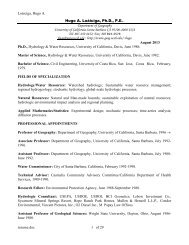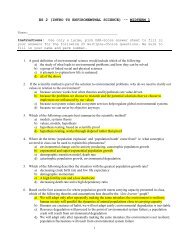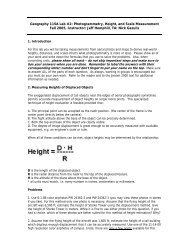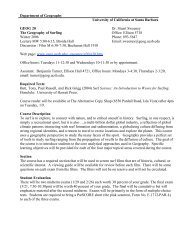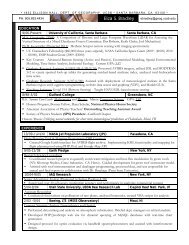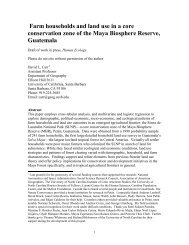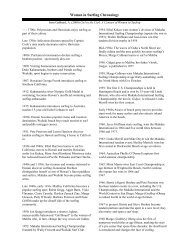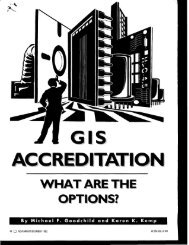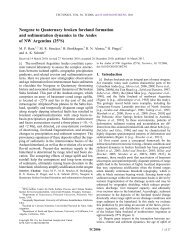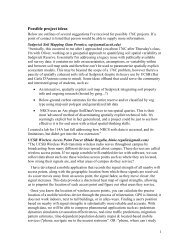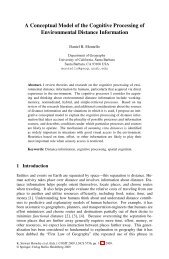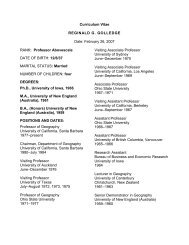Spatial knowledge acquisition from direct experience in the ...
Spatial knowledge acquisition from direct experience in the ...
Spatial knowledge acquisition from direct experience in the ...
You also want an ePaper? Increase the reach of your titles
YUMPU automatically turns print PDFs into web optimized ePapers that Google loves.
112 T. Ishikawa, D.R. Montello / Cognitive Psychology 52 (2006) 93–129<br />
Table 5<br />
Correlations between self-report sense-of-<strong>direct</strong>ion and mean performance across all sessions<br />
Task U-route S-route Integrated routes<br />
Direction ¡.43 ¤ ¡.36 ¡.45 ¤<br />
Route distance ¡.09 .05<br />
Straight-l<strong>in</strong>e distance .48 ¤ .00 .29<br />
Sketch map .59 ¤¤ .32 .32<br />
¤ p < .05.<br />
p < .01.<br />
high correlation, we used <strong>the</strong> mean of each participant’s two adm<strong>in</strong>istrations as our measure<br />
of self-report sense-of-<strong>direct</strong>ion.<br />
Table 5 shows <strong>the</strong> correlations between self-report sense-of-<strong>direct</strong>ion and participants’<br />
mean performance across all sessions. Negative correlations with po<strong>in</strong>t<strong>in</strong>g errors and positive<br />
correlations with distance and bidimensional correlations mean that participants with<br />
a better sense-of-<strong>direct</strong>ion tended to perform better on <strong>the</strong> tasks. Participants’ self-rat<strong>in</strong>gs<br />
of sense-of-<strong>direct</strong>ion correlate weakly, if at all, with <strong>direct</strong>ion estimates on <strong>the</strong> S-route,<br />
route distance estimates on both routes, and straight-l<strong>in</strong>e distance estimates and sketch<br />
mapp<strong>in</strong>g on <strong>the</strong> S-route and <strong>the</strong> <strong>in</strong>tegrated routes. In contrast, sense-of-<strong>direct</strong>ion rat<strong>in</strong>gs<br />
moderately and signiWcantly correlated with <strong>direct</strong>ion estimates on <strong>the</strong> U-route and<br />
between <strong>the</strong> routes, straight-l<strong>in</strong>e distance estimates on <strong>the</strong> U-route, and sketch mapp<strong>in</strong>g on<br />
<strong>the</strong> U-route. We calculated a composite performance score based on <strong>the</strong>se latter measures<br />
(after converted <strong>in</strong>to z-scores), and found that it correlated .56 (p < .01) with sense-of-<strong>direct</strong>ion<br />
rat<strong>in</strong>gs. Fig. 7 shows a scatterplot of this relationship for <strong>the</strong> 24 participants.<br />
3.3. Sex-related diVerences<br />
This research was not speciWcally designed to address sex-related diVerences <strong>in</strong> largescale<br />
spatial abilities, but <strong>the</strong> data showed a pattern (Fig. 8) similar to what has been<br />
reported <strong>in</strong> <strong>the</strong> literature on environmental spatial cognition (e.g., Montello, Lovelace,<br />
Golledge, & Self, 1999; for a discussion of sex-related diVerences <strong>in</strong> general spatial abilities,<br />
see McGee, 1979). Mean performance by men (n D 11) was signiWcantly better than<br />
that by women (n D 13) on tasks that required accurate survey <strong>knowledge</strong> of <strong>the</strong> layout<br />
ra<strong>the</strong>r than route <strong>knowledge</strong>: <strong>direct</strong>ion estimates for both routes separately and <strong>the</strong> <strong>in</strong>tegrated<br />
routes; straight-l<strong>in</strong>e distance estimates for <strong>the</strong> U-route and <strong>the</strong> <strong>in</strong>tegrated routes;<br />
sketch mapp<strong>in</strong>g for both routes and <strong>the</strong> <strong>in</strong>tegrated routes. On average, men rated <strong>the</strong>ir own<br />
sense-of-<strong>direct</strong>ion as better than did women, but <strong>the</strong> diVerence did not reach signiWcance.<br />
4. Simulations<br />
Our aggregate analyses <strong>in</strong>cluded a comparison of mean performance <strong>in</strong> <strong>the</strong> Wrst session<br />
to a pure chance level (i.e., an absolute <strong>direct</strong>ion error of 90°, a distance correlation of 0, a<br />
sketch-map correlation of 0). Performance was better than chance for all tasks, except for<br />
distance correlations on <strong>the</strong> <strong>in</strong>tegrated routes after guess<strong>in</strong>g <strong>in</strong> Session 3 and after Wrst<br />
exposure to <strong>the</strong> connect<strong>in</strong>g-route <strong>in</strong> Session 4. Comparison to pure chance is not a very<br />
str<strong>in</strong>gent test of performance, however; it only tells us that participants had at least some<br />
very m<strong>in</strong>imal spatial <strong>knowledge</strong>. Pure chance performance implies an agent that nei<strong>the</strong>r



